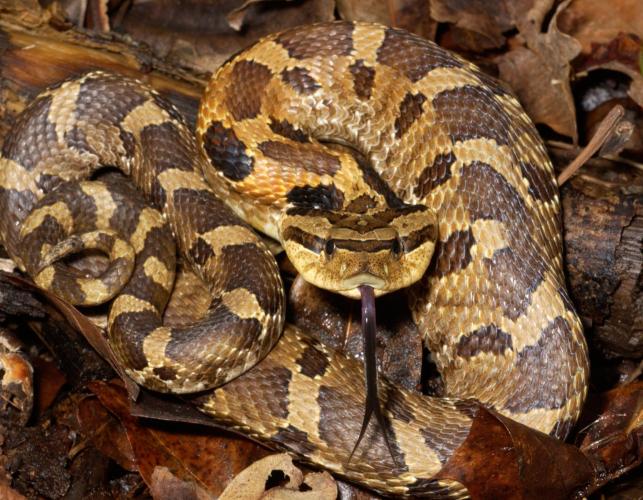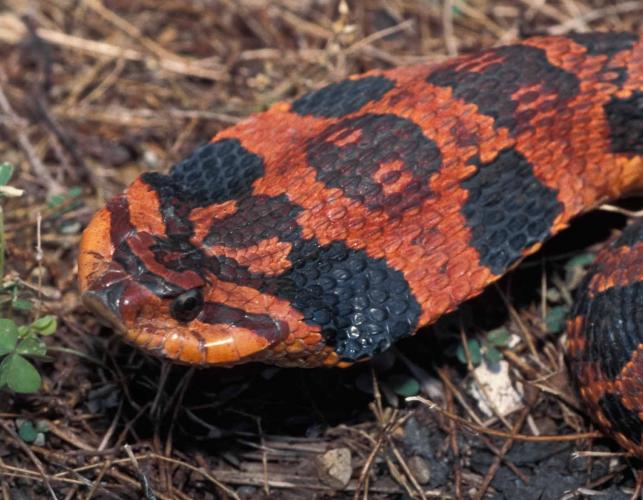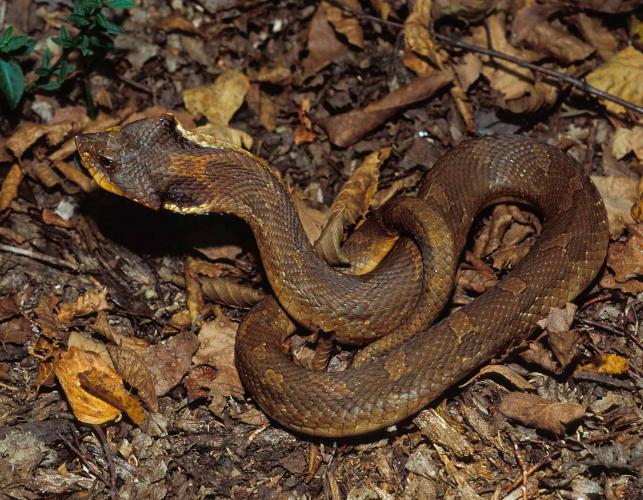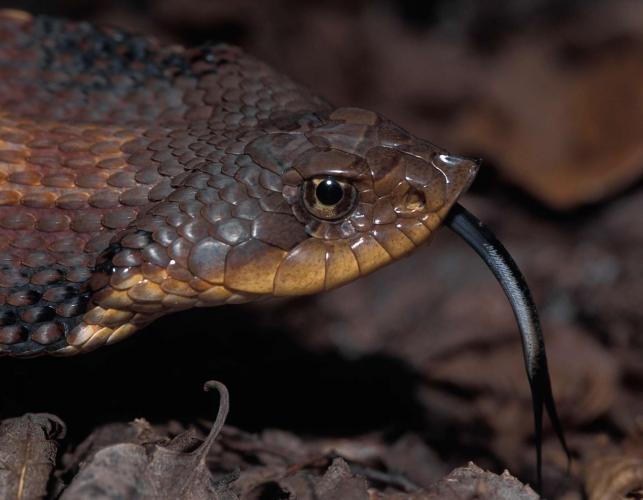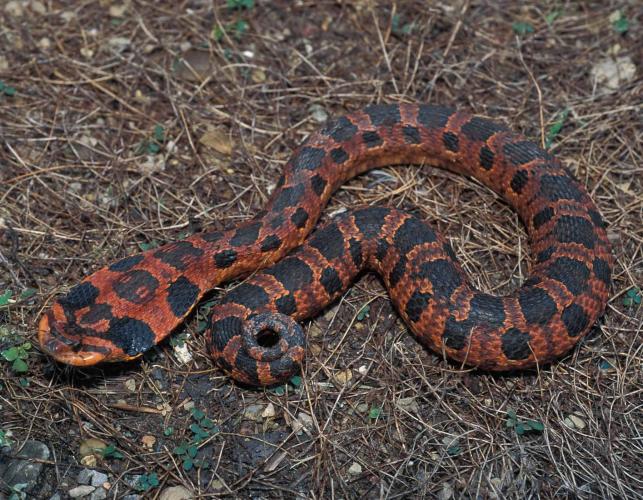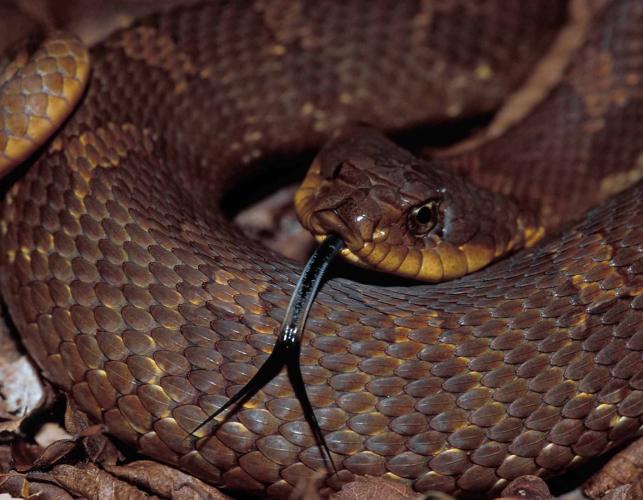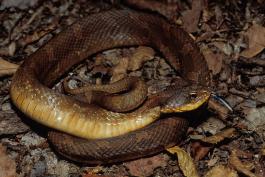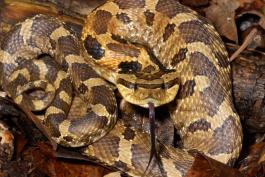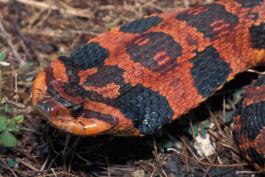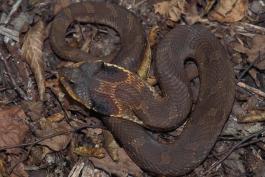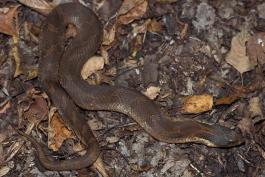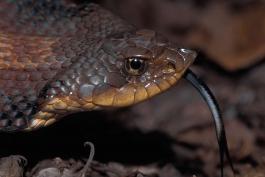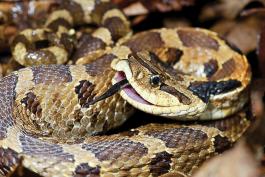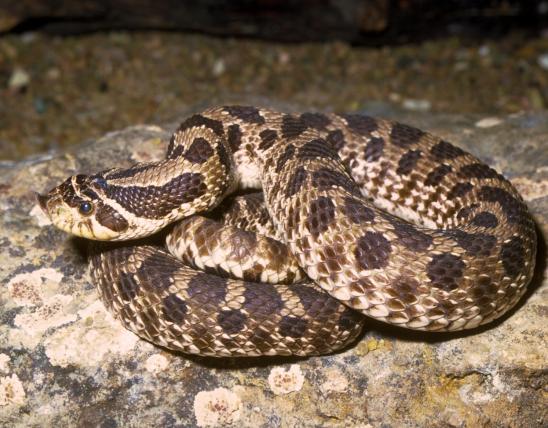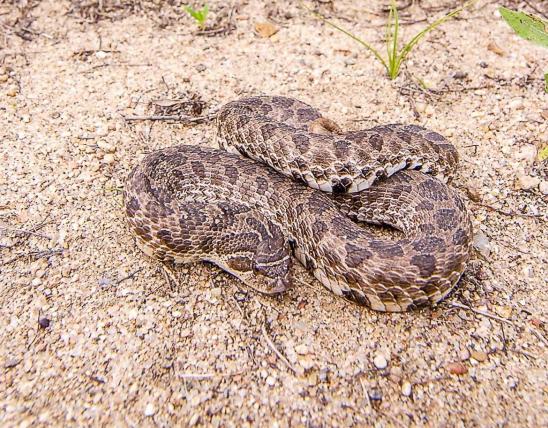
The eastern hog-nosed snake is a medium-sized snake with a heavy body and a pronounced upturned snout. Compared to other snakes of similar size, hog-nosed snakes have large eyes and a short tail. The color of this species is highly variable. Its ground color is gray, tan, yellow, brown, olive, or orange. Individuals can have a series of 20–30 brown upperside blotches with a smaller light marking between them, or they can be dull colored and lack markings on the back, except near the head. With heavily marked specimens, there are several additional dark markings on the head: a V-shaped marking behind the eyes, plus a dark bar across the head between the eyes, and a diagonal dark bar from each eye to the corners of the mouth. In some part of the species' range, individuals may be jet black on the back. The belly is gray, yellow, or pink, mottled with gray or greenish gray. The underside of the tail is normally lighter than the belly. Even on individuals with no upperside markings, there is always a pair of large dark brown or black blotches behind the head. The scales on the back are keeled, and the anal plate (the last belly scale, which covers the anal opening) is divided.
Newly hatched eastern hog-nosed snakes are more colorful than adults, with numerous brown, black, tan, yellow, or orange blotches that can form bands toward the tail.
This is the only common species of hog-nosed snake in Missouri.
When threatened, an eastern hog-nosed snake will flatten its head and neck, hiss loudly, and even strike; but this is an act and the mouth is closed. Although it can look intimidating, remember that this is a nonvenomous snake. If its threatening bluffs fail to ward off an enemy, the snake may go into convulsions, thrash around, open its mouth, let its tongue hang out, regurgitate any prey animal from its stomach, release feces from its cloaca, roll over on its back, and play dead. You can expose this as a fake death by gently rolling the snake back onto its belly; it will immediately roll over onto its back again. If the intruder moves away, and the hog-nosed snake is left alone, it will eventually slowly roll over onto its belly, cautiously look about, flick its tongue to make sure it is safe, and move away to safety.
Similar species: The plains hog-nosed snake (H. nasicus) and dusty hog-nosed snake (H. gloydi) — virtually indistinguishable from each other — both have a sharply upturned snout and black pigment on the underside of the tail. Both are very rare in our state. The plains hog-nosed snake was once known only from loess hill prairies in extreme northwestern Missouri and is probably extirpated. The dusty hog-nosed snake is restricted to sand prairie and savanna areas of southeastern Missouri.
Adult length: 20 to 33 inches; occasionally to 50 inches. Males are smaller than females; the tail of males is longer than females.

Presumed to occur statewide. The overall North American range includes the entire eastern half of the United States, extending west to southeastern South Dakota and the eastern half of Texas.
Habitat and Conservation
Eastern hog-nosed snakes live in areas of sandy or loose soil in open woods, old fields, open river floodplains, and on rocky, wooded hillsides. This snake is commonly seen when it is crossing a country road, woodland trail, or moving across a cultivated farm field.
This species is active during the day. During the active season, it takes shelter in the burrows of small mammals or it burrows into loose soil or sand. On occasion, it hides under a flat rock or under boards, old pieces of tin, or other human-made objects.
Overwinter dormancy lasts from early November to April. Eastern hog-nosed snakes overwinter in abandoned small mammal burrows (primarily those made by moles), in burrows dug by themselves, or within old logs and stumps.
Food
Eastern hog-nosed snakes eat toads. Their prominent, upturned snout, found on few other species in Missouri, is used to dig and poke through loose or sandy soil in a deliberate effort to locate toads. The search for prey usually takes place in the morning.
Hog-nosed snakes are the primary predator of toads in North America. This includes our true toads of the genus Anaxyrus and spadefoots, Scaphiopus and Spea. Toad skin secretions are toxic and few predators eat them. But species of snakes in the genus Heterodon (hog-nosed snakes) are immune to toad toxins (bufotoxin), so they can eat toads with no ill effects. However, they are also known to eat a variety of frogs, terrestrial salamanders, lizards and their eggs, ground-nesting bird eggs, and small mammals such as mice and shrews.
Apparently, a pair of large teeth on the upper jaw, in the back of the mouth, assist in swallowing large prey. These teeth are used for holding and deflating toads that are full of air, and to subdue prey by injecting a toxic saliva by prolonged chewing. These snakes have a gland (called Duvernoy’s gland) that produces a mild venom. The venom glands are in association with the salivary glands, and their secretions will enter a prey animal as it is being swallowed. This toxin helps subdue the prey for ease of swallowing.
Life Cycle
Mating occurs in April and May, and also, less frequently, in September and October. The female lays only 1 clutch per year, in June or July, consisting of 4–61 eggs (with an average of 22). These are usually deposited in a shallow burrow in sand or loose soil, but they may also be laid in old sawdust piles, beneath rocks, and small mammal burrows. After an incubation period of 50–65 days, hatching occurs in August or September. The young are brightly colored and about 9 inches long when they hatch. Eastern hog-nosed snakes become mature at about 2 years of age.
Human Connections
As far as humans are concerned, hog-nosed snakes are nonvenomous. The saliva of hog-nosed snakes has been shown to be essentially not toxic to humans: although some persons, if bitten on the hand by a hog-nosed snake, may develop a burning or tingling sensation with a little swelling of the hand, these symptoms are short-lived. It should be emphasized that hog-nosed snakes are not aggressive; they rarely if ever bite people — even when freshly captured — and they are not considered a threat to humans.
It is a cruel irony, from the snake's perspective, that its hissing and defensive behaviors — which work so well in defending them against their natural enemies — cause them to be frequently misidentified as dangerous and killed by humans out of unwarranted fear. Educate yourself and others about these amazing animals, their interesting behaviors, and their role in nature.
Colorful local names have been applied to this harmless snake, including "blow snake," "spreadhead," "puff adder," and "hissing viper." Animals with remarkable characteristics, and capable of inspiring strong emotions, hold psychological and symbolic significance for humans, as seen in cultures worldwide.
Ecosystem Connections
Although we quickly, and rightly, think of snakes as predators, this snake is also a prey species. Its elaborate defense tactics, ranging from a fierce (though harmless) attack display to a truly convincing death act, remind us that many predatory mammals and birds relish the meat of this reptile. Even newly hatched hog-nosed snakes can perform both defensive behaviors (the "cobra" threat as well as the fake death), and hog-nosed snakes have been documented performing the death act while in water. Predators include hawks, owls, kingsnakes, racers, and coachwhip snakes. Their eggs are likely eaten by raccoons, skunks, and badgers.
In another defensive behavior, a hog-nosed snake typically turns its head toward its body while exposing the coiled tail as a means of protecting the head.
A study of hog-nosed snake saliva indicated it is somewhat toxic to amphibians but not to laboratory mice. This is an indication of how specialized hog-nosed snakes are for eating toads and frogs.
Hog-nosed snakes are routinely parasitized by flukes (parasitic flatworms in class Trematoda, including Ochetosoma ellipticum and O. elongatum, though there are many more). These parasites look like small black objects (only a few millimeters long) in the open mouth of a hog-nosed snake; there may be 1–6 or more of them in a single snake's mouth, plus more elsewhere in the digestive tract, lungs, and so on. These are the adult stages of native amphibian parasitic flukes, which, as tiny larvae, live in the bladder and lungs of toads, frogs, and tadpoles. When a hog-nosed snake eats an infected toad or frog, the fluke’s larvae eventually enter and parasitize the snake’s internal organs, including the mouth. The life history of these common amphibian internal parasites is quite complex, and at least four different animal hosts may be part of a flukes' life cycle. Hog-nosed snakes aren't the only ones susceptible; racers, gartersnakes, watersnakes, and others are also commonly parasitized by these flukes.

